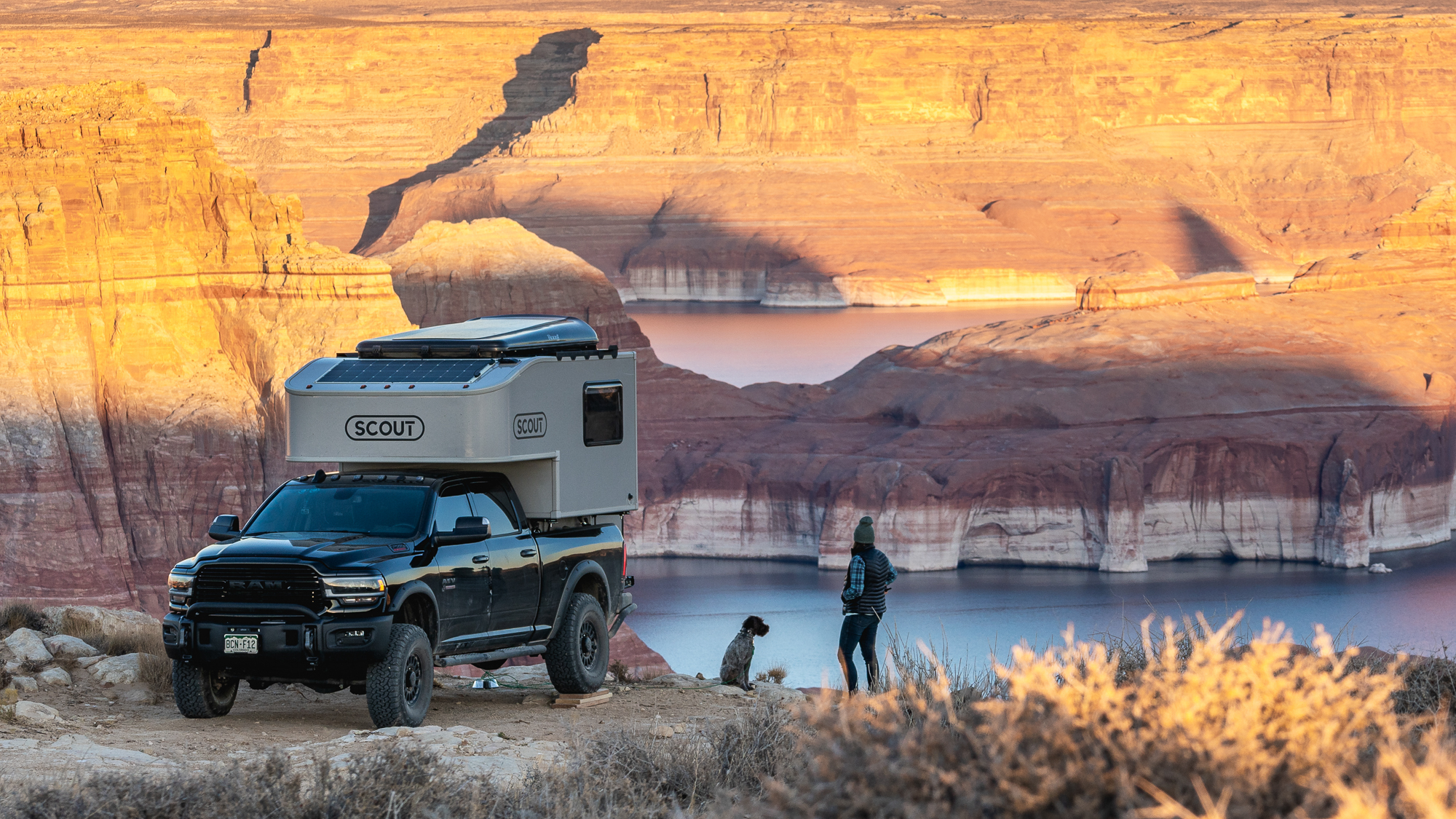Photography by Mike and Dani Mortell
The Backstory
Having never before set foot in Colorado, I decided to take a job that would land my partner, Mike, and me in the foothills of Boulder in 2018. As a couple of outdoor enthusiasts, we knew this state and its neighbors held boundless opportunities to keep us entertained. So without hesitation, we bid Atlanta farewell, and off we went.
We made the drive in Mike’s 2014 GMC Sierra—the same vehicle where he had recently slept many a night in the truck bed as he made his way across the country on an in-between-jobs road trip. Unbeknownst to us at the time, this truck would soon become our first camping rig.
Not long after settling into our new life, Mike envisioned building out the GMC with a truck bed topper, basic drawer system, and sleeping platform. It took me a while to understand why we would spend money to outfit the truck when we could go backpacking or camping without a vehicle. Was sleeping in the bed of a truck with the luxuries of a structural roof over your head, all the equipment you could carry, and the lack of effort required to set up and tear down even camping? It seemed so glamorous, and I wasn’t sure I wanted to be a glamper.

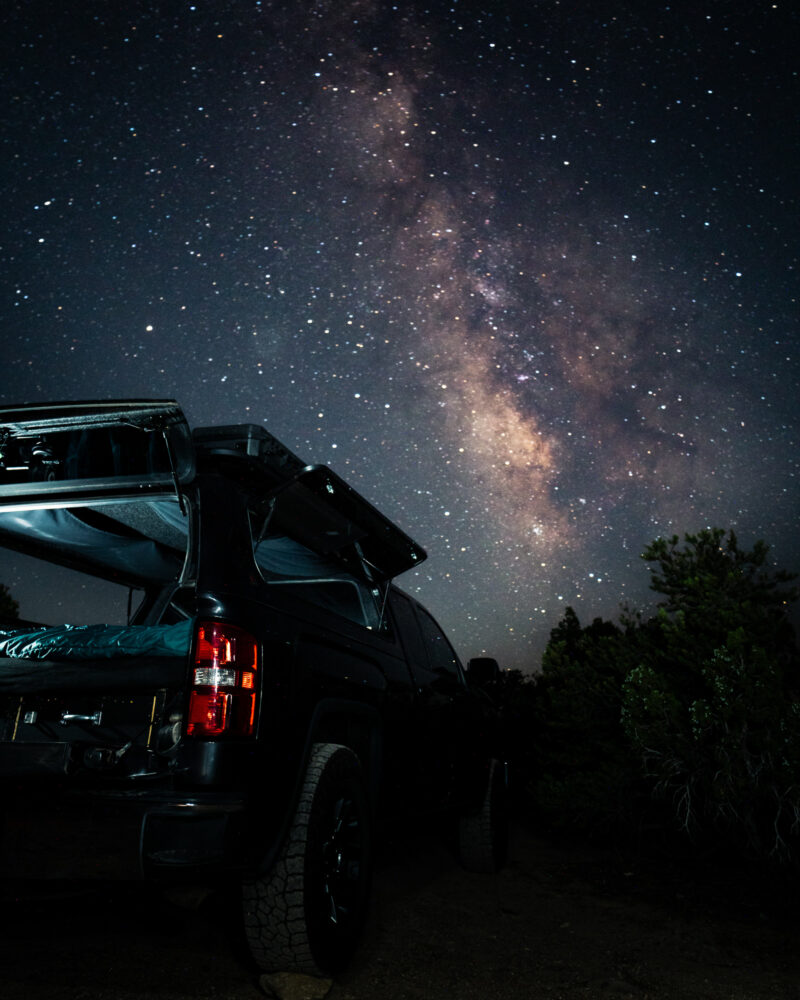
However, very soon after Mike completed the build, I could see the value. We had so much mobility, and the convenience of pulling up to camp with everything being ready to go gave us more time to enjoy the experience and explore more. I was hooked. We loved this rig and what it empowered us to do. We explored all over our new home state, slept at trailheads and ski resorts to get an early jump on crowds, and were perfectly happy with our setup.
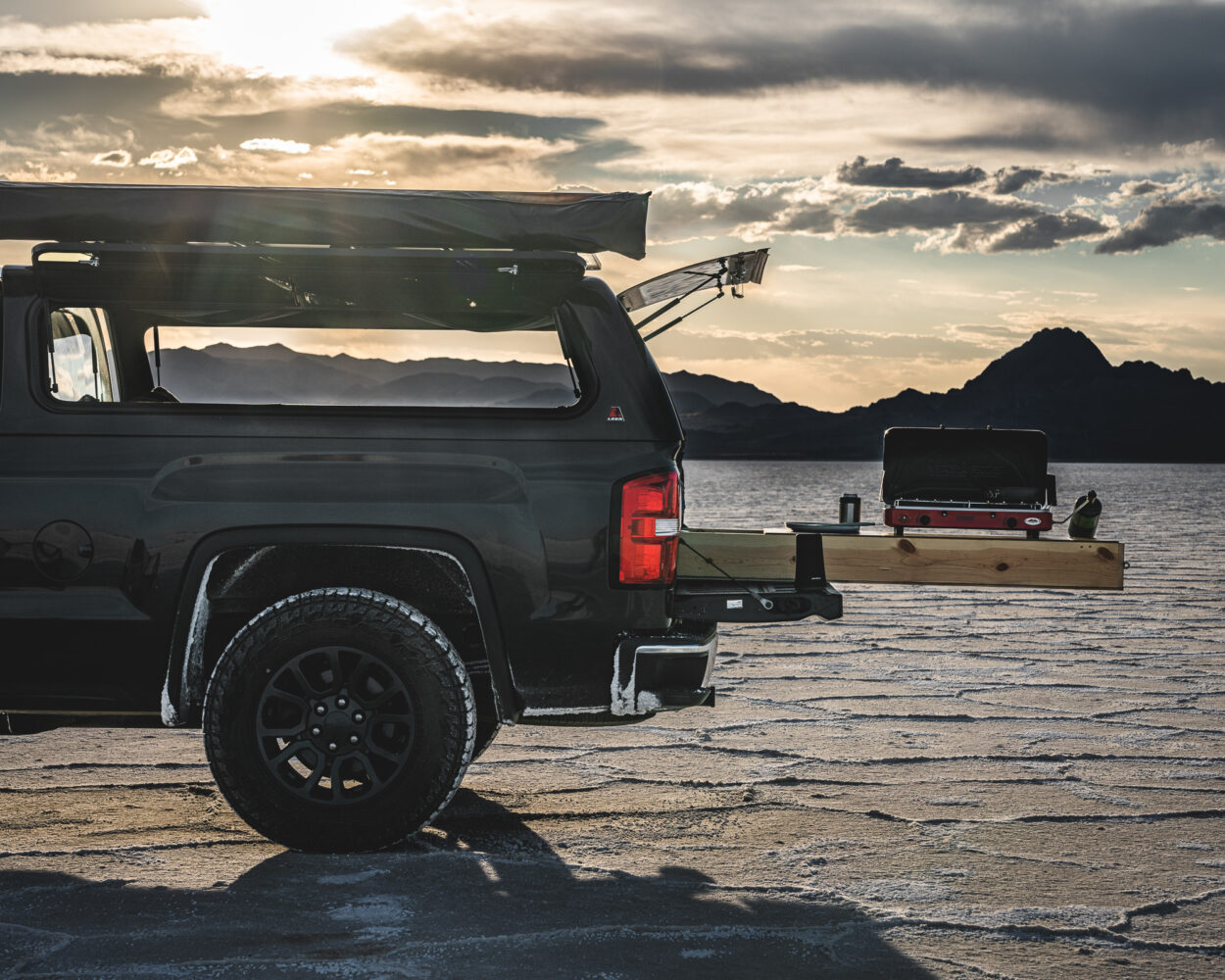
That is, until one beautiful weekend in May 2020. We were camping with two of our friends at one of our favorite spots in Colorado with stunning mountain views, glistening lakes below, and dense aspen trees littering the trails. We had spent the day mountain biking and were relaxing at camp in our socially distanced hammocks when our friends shared some big news: they were getting a puppy! Hearing this was the nudge we needed to take the plunge into puppy parenthood for ourselves, as we had been teetering dangerously on the edge for some time.
We couldn’t wait to have a fun-loving pup bouncing around camp with us, but we had to consider the reality of adding one to our crew. This was a pivotal decision for our outdoor life. Our sleeping quarters were already small, and as you may know, puppies tend to pee where they shouldn’t. It seemed unlikely that our sleeping bag and mattress would make it out of the early months unscathed.
In addition to our growing family and the desire for more space, we both had a newfound ability to work from home due to the Covid-19 pandemic. The thought of self-isolating outdoors rather than inside, taking longer trips (with both our new dog-to-be, Granger, and cat, Walker), and working from camp was intriguing. A truck bed camper seemed like a natural next step for us to bring this vision to life, so I tossed my aversions to glamping and large purchases aside, and we moved forward with the plan.

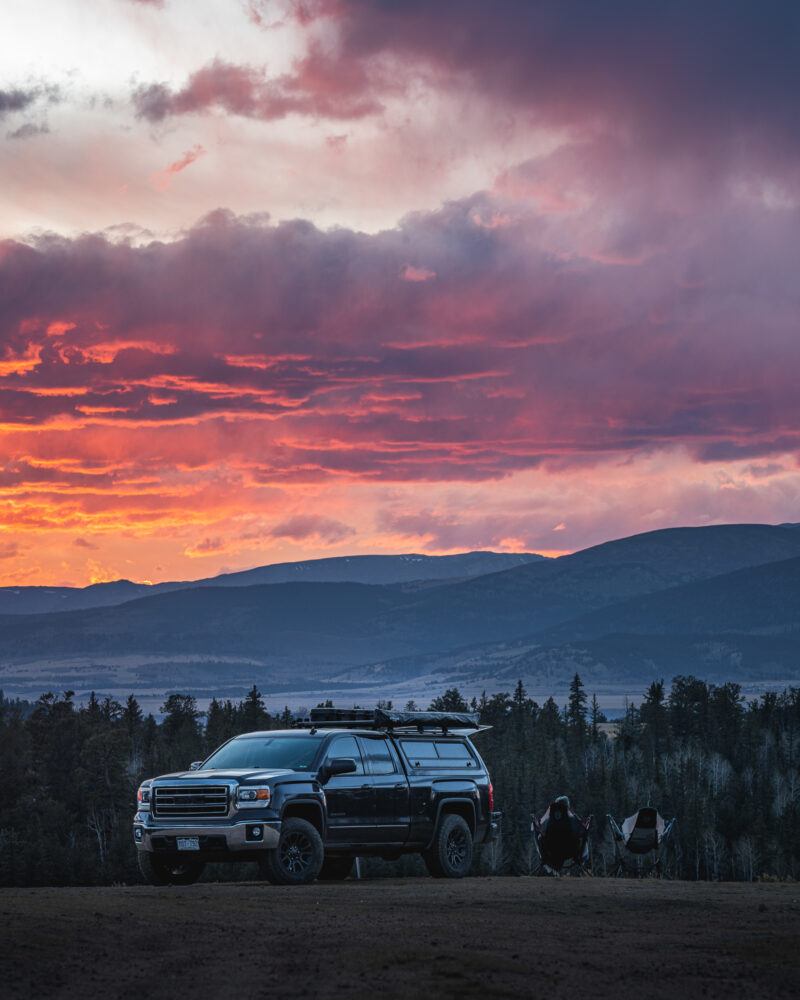

–
By the time we were seriously looking for a truck bed camper to call our part-time home, we were well into the pandemic, and demand for any RV or camper was through the roof. We looked into a few different manufacturers and used options, but either the lead times were way longer than we cared to wait, or they didn’t fit what we wanted. That was until we came across Scout Campers.
Scout was a new brand to the industry and their lead times were much more reasonable at the time. On paper, the Scout Olympic camper sounded like everything we were looking for: lightweight, simple, and manageable for our GMC 1500—with only a few tweaks. We placed our order for the Scout Olympic model in June of 2020 and began the countdown to the day we would pick it up in Pueblo, Colorado, four months later.
The Truck
Now here’s a plot twist: the day we picked up our camper, it was not in our trusty 2014 GMC Sierra, but rather, we rolled onto the dealer’s lot in a new, black 2020 Ram 2500 Limited Night Edition with the AEV Prospector package and a Cummins diesel engine. To this day, I’m not sure how we went from ordering the Scout Olympic for our GMC Sierra to buying a brand-new (and beefy) truck. But, if you asked Mike, he would logically explain that the more he considered the reality of the weight of a fully loaded Scout Olympic and the upgrades the GMC would need to support it, upgrading to a 2500 truck seemed like the better option for the additional payload capacity and power. We considered sticking with GMC but landed with the Ram 2500 because it offered greater value than other comparable options; we purchased an upgraded model (with a heated steering wheel and all) for close to the same cost as a simpler model from other manufacturers.
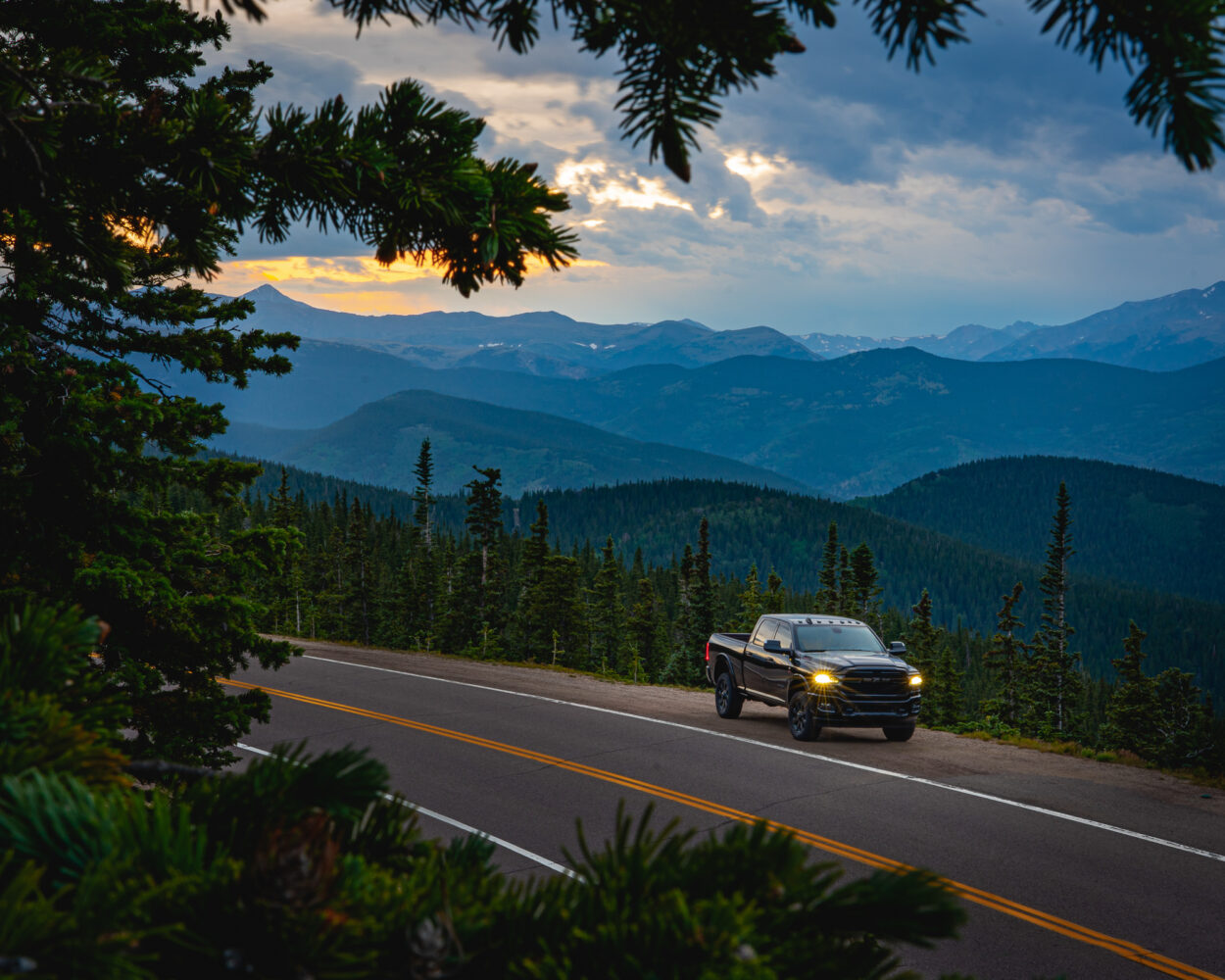

The Cummins diesel engine did bring the power in spades, though its hefty weight sacrificed some of the gains in payload capacity. All in all, the payload increased by approximately 500 pounds from the GMC 1500 to the diesel Ram 2500.
The decision to go with a diesel wasn’t as transparent as we initially thought. Yes, it’s powerful, more efficient, and its quiet growl lulls our cat, Walker, to sleep on long drives. Our under-researched expectation was that it would be a more accessible fuel source internationally. However, merely two weeks after buying the truck, as we listened to the Overland Journal podcast, we were surprised to learn that this expectation was essentially wrong. Because of the ongoing global transition to ultra-low-sulfur diesel, it is not yet readily available in many countries. Meaning our ULSD-required truck would not fare too well far from home. This would be a problem for our future selves, so we decided to deal with it when the time came.

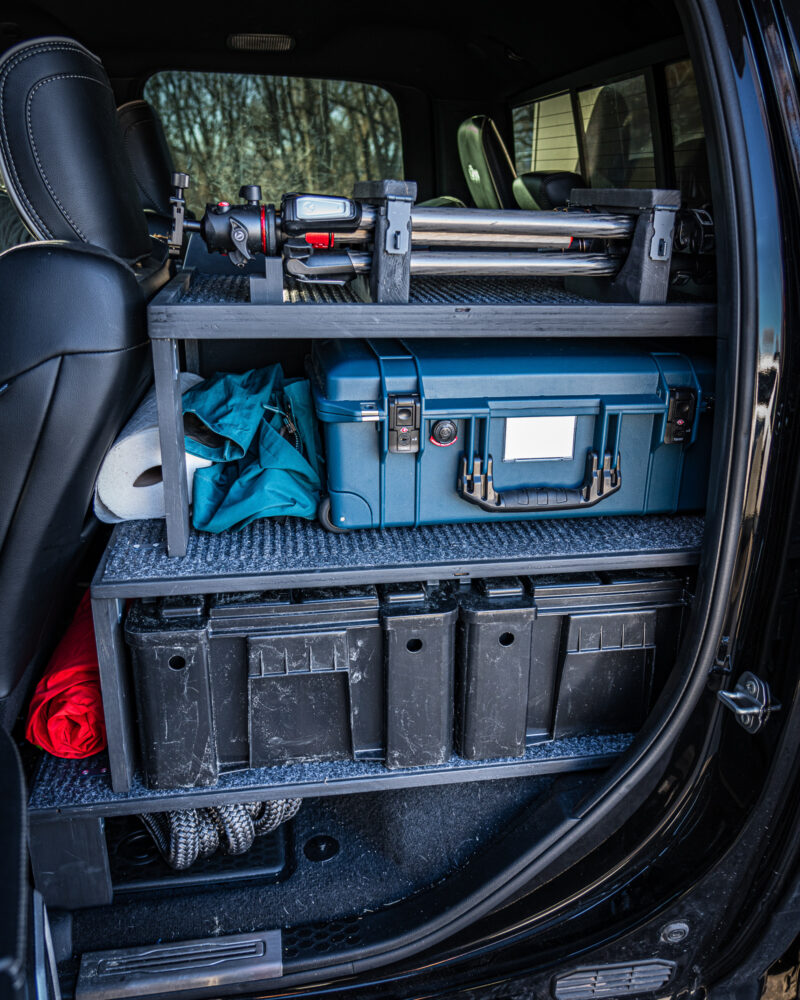
Diesel hiccups and international travel implications aside, we still had big plans for this truck. Adding the AEV Prospector package not only looked spectacular, but it significantly bumped up the truck’s off-road capability. The 3-inch lift and the 37-inch BFGoodrich AT KO2 tires created higher ground clearance and solid traction for 4WD trails. And the winch has come in handy a few times to rescue fellow travelers. To create additional storage space in the truck cab, we removed the 40-percent back seat and built a custom shelf system, leaving plenty of room for Granger and friends to ride in the cab’s back seat.

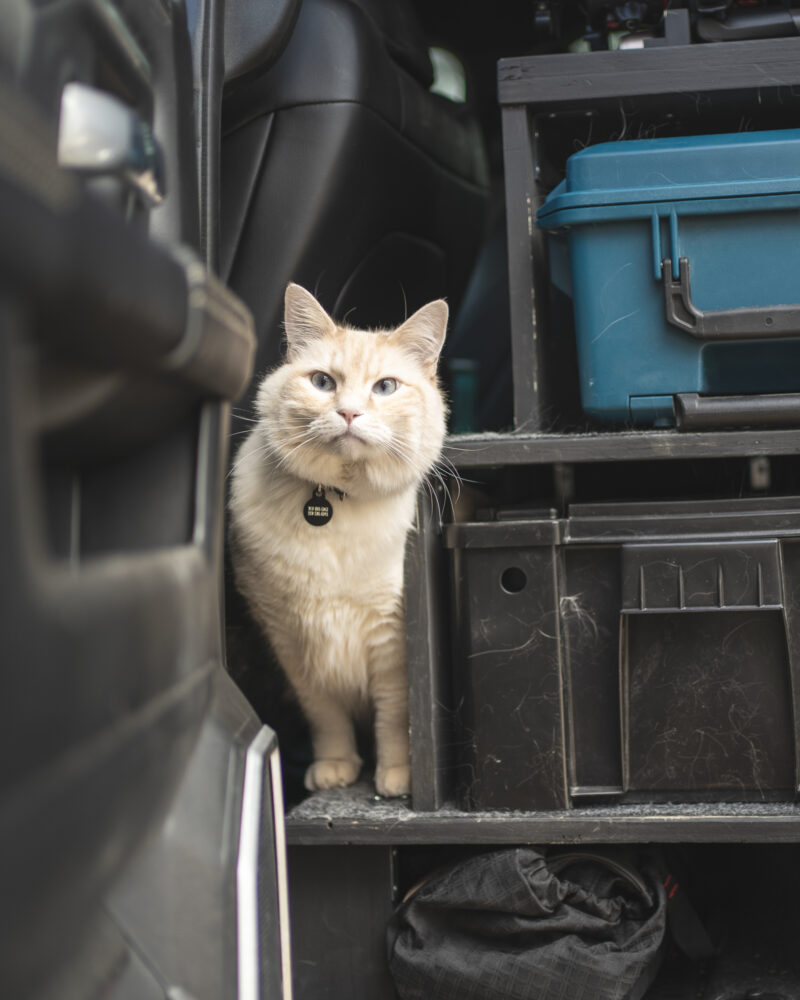
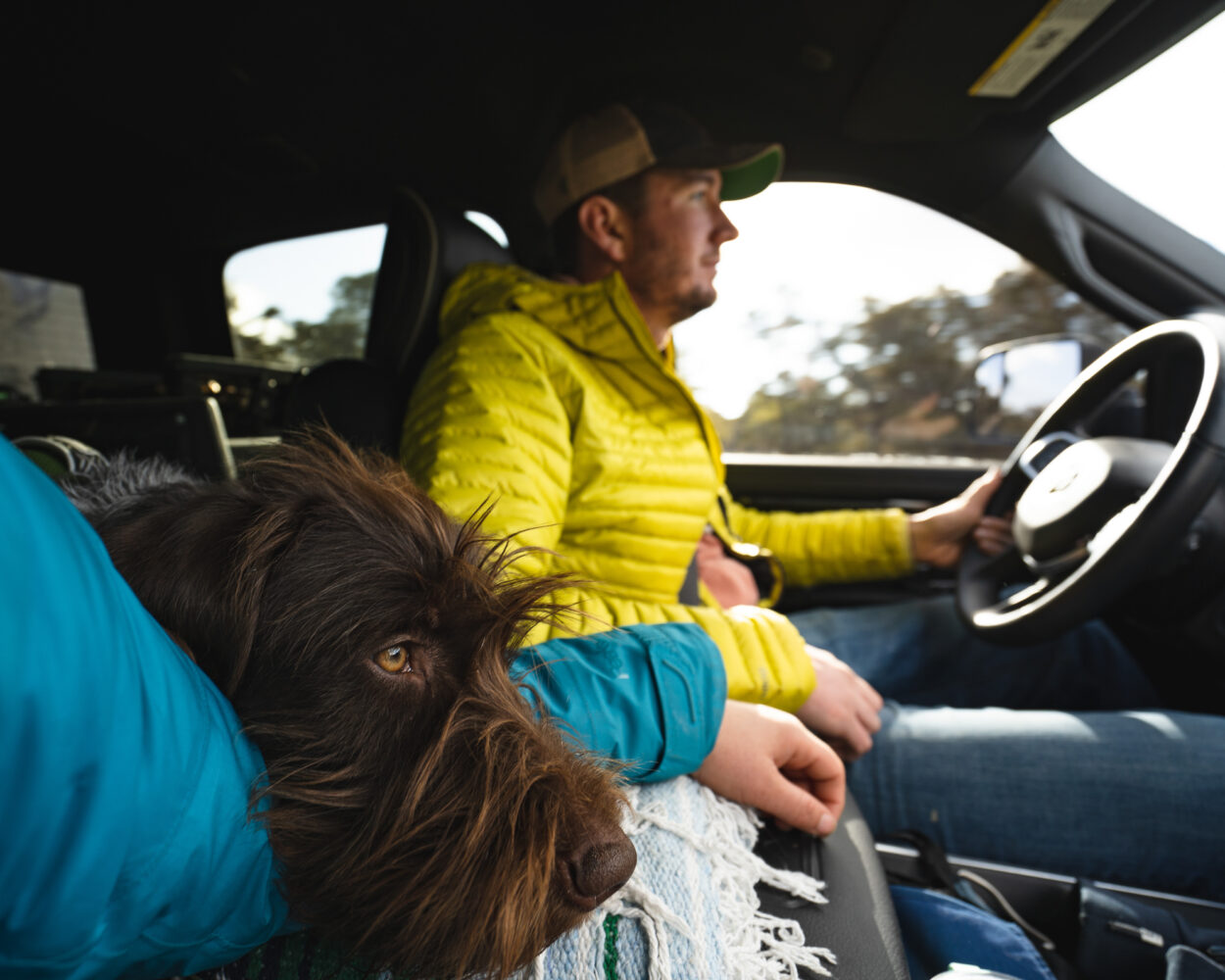
The rugged look and impeccable quality of the AEV Prospector are hard to beat. We can attest that ours has tackled quite a few gnarly trails, including ones on which you wouldn’t typically see a truck bed camper. In retrospect, we might have made some choices differently with regards to the truck build, but it has served us well, and we love it nonetheless.
The Camper
In selecting our truck bed camper, our priorities were aligned with what many would describe as the KISS framework: Keep It Simple Stupid. We were looking for a lightweight option with more space t and all-season capability. The simplicity of the Scout and its innovative structure are some of its greatest advantages and partly what sets them apart from other truck bed campers. It requires no winterization, has very few potential points of failure, and offers solid but light insulation for winter camping.
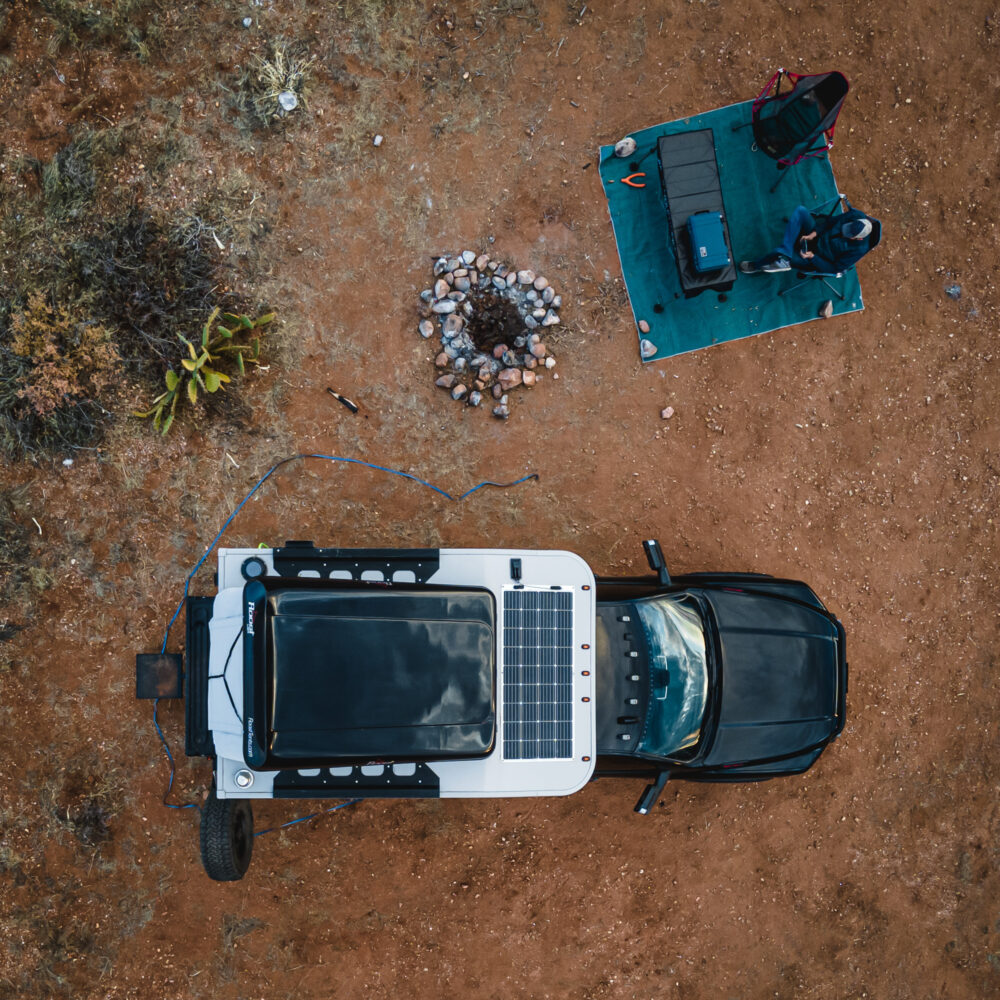
We picked up the camper in late October of 2020 without ever having seen one in person. Photos and videos were sparse online, but thankfully, we liked what we saw. The sleek and modern-looking Scout Olympic camper complemented our truck well. The minimalistic style and modular components keep things uncomplicated, convenient, and adjustable. Not to mention, it answered the call for more space. Mike, who is 6 feet, 5 inches tall, can comfortably sleep on the extra-large full-size bed and fully stand up inside the camper, which is a luxury that not all adventure vehicles can offer him.

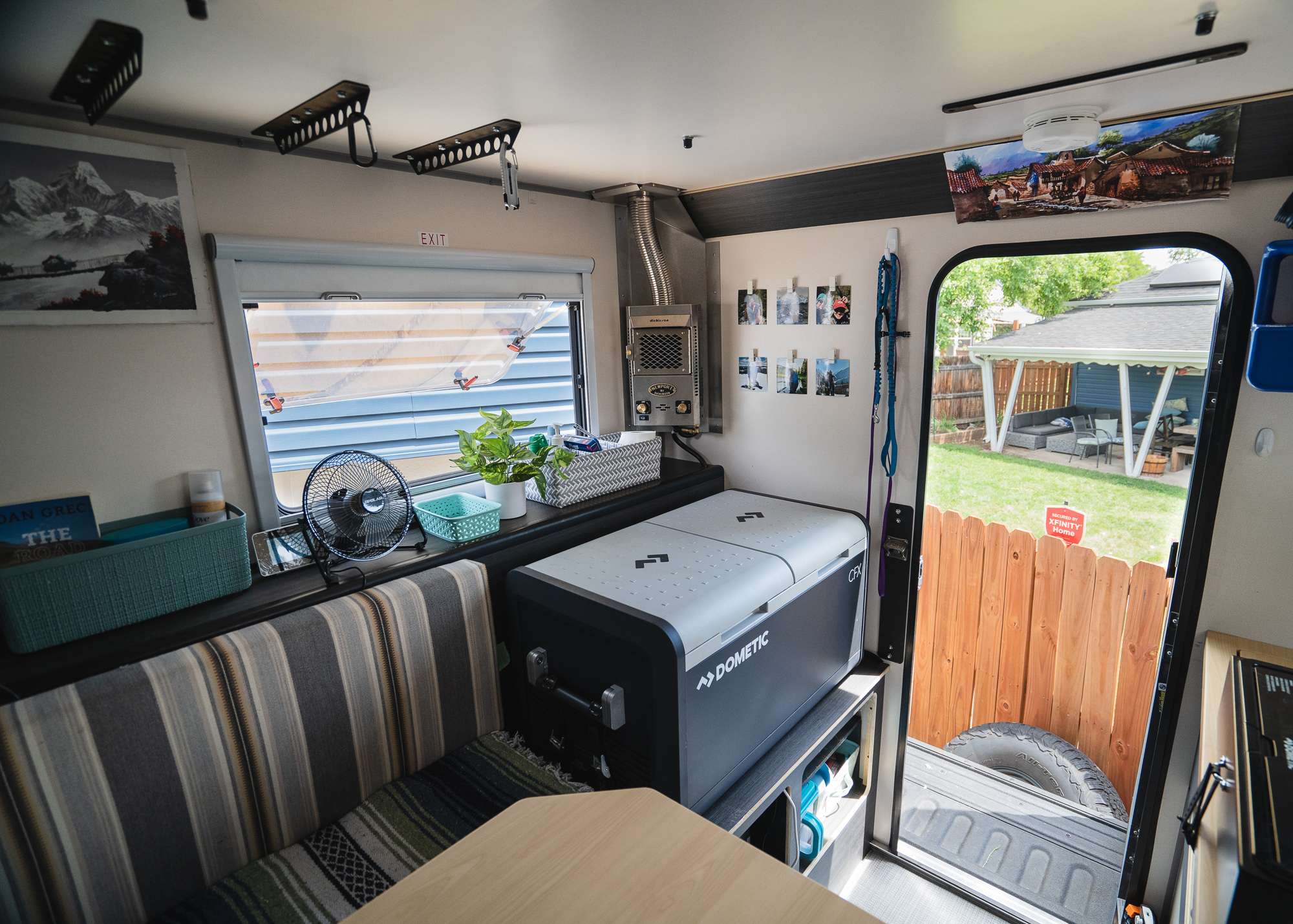
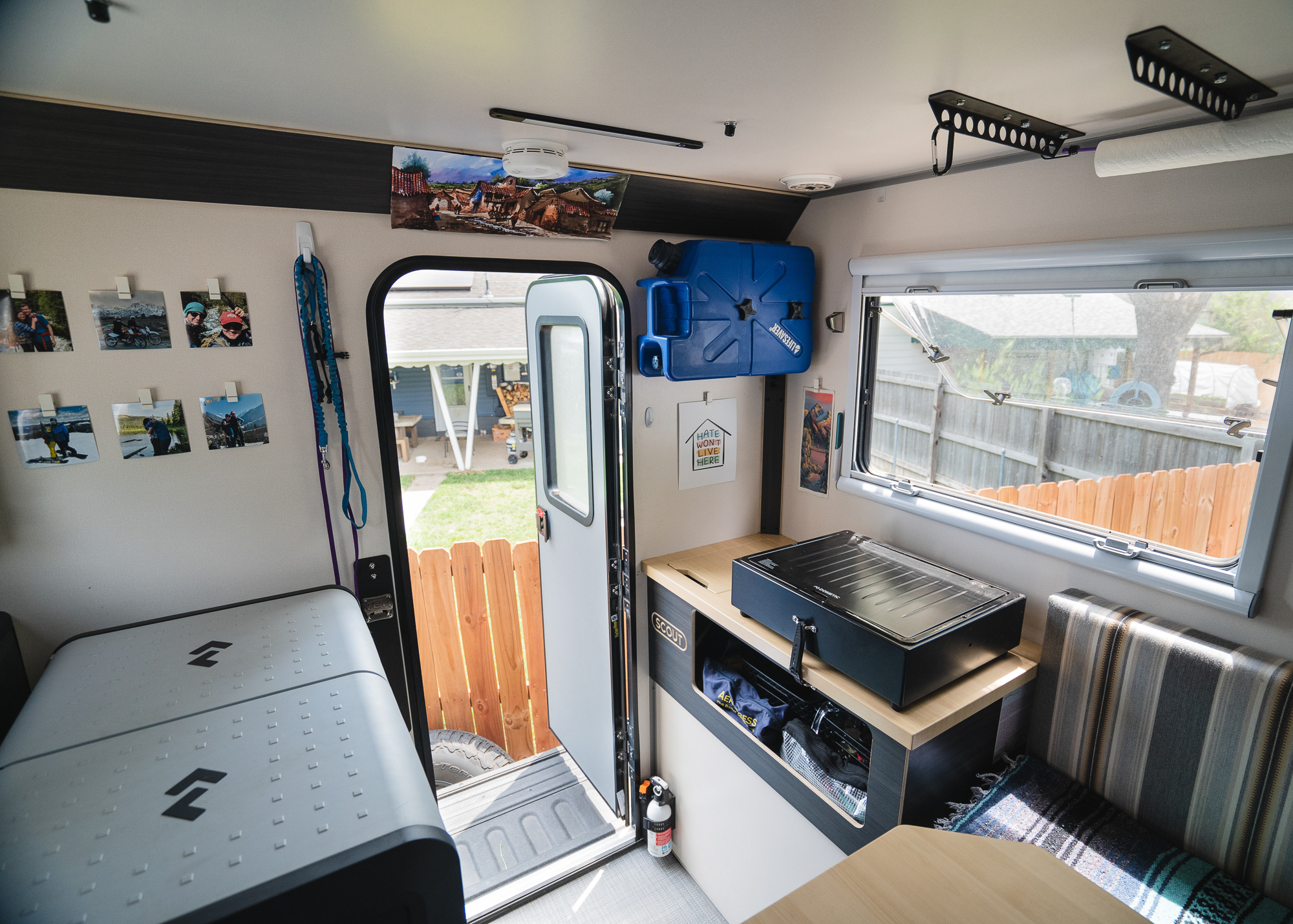
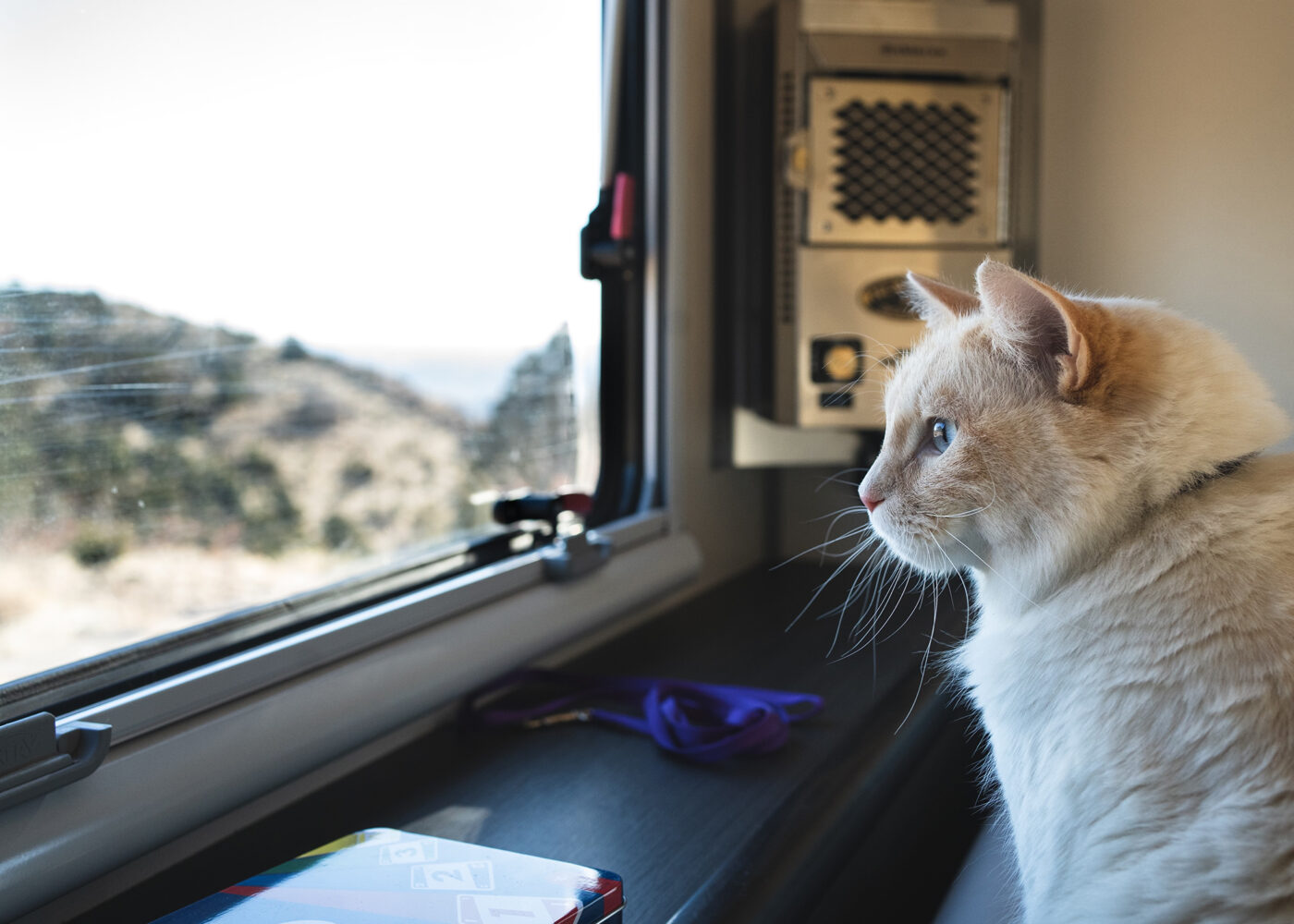

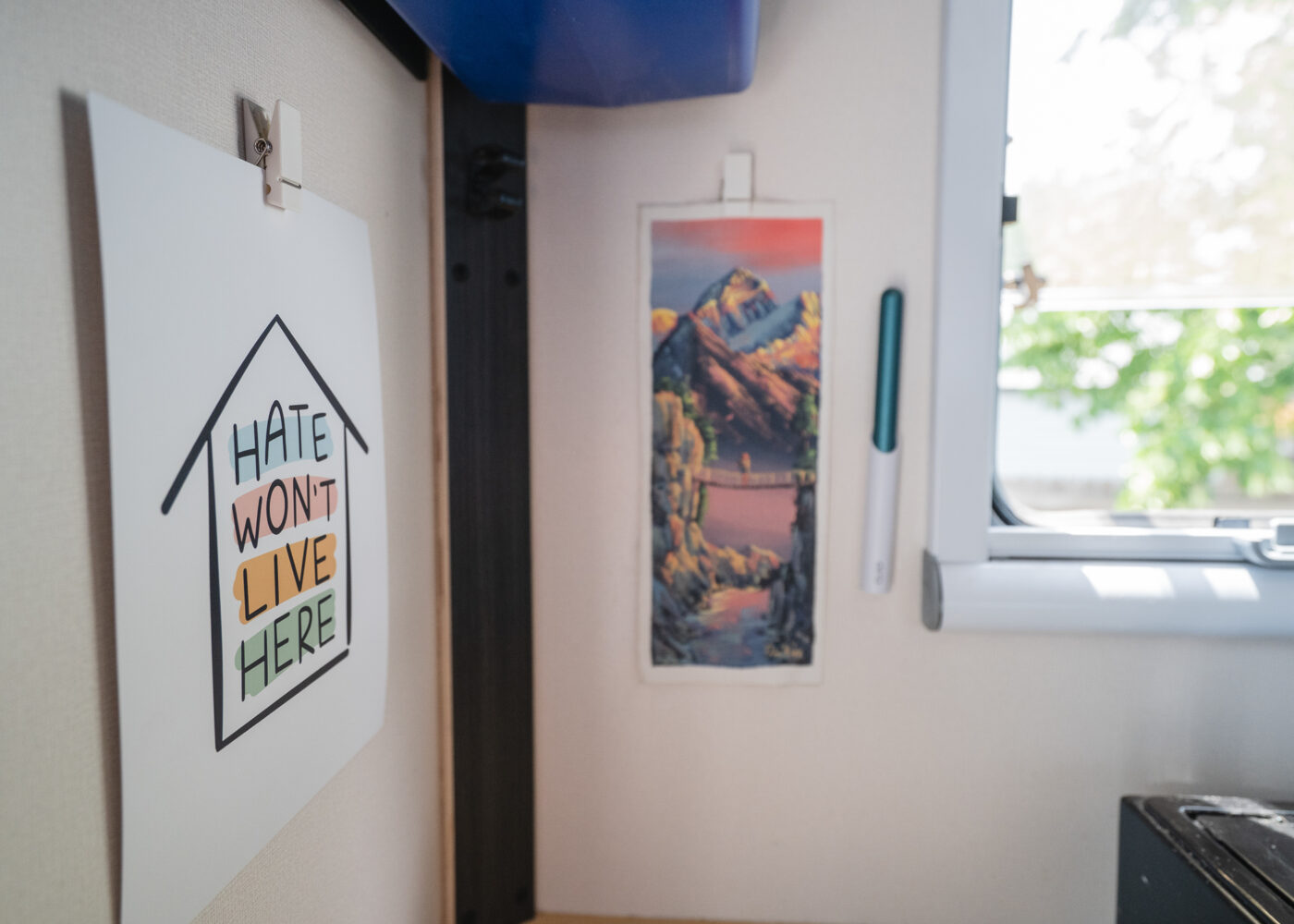
The camper’s systems are straightforward, just like we wanted them. Each Scout is equipped with a removable 4.6-gallon LifeSaver jerry can, which can purify water from sources like lakes, rivers, and even muddy puddles. There are no graywater or blackwater tanks built-in, but there is a direct exterior drain running from the sink to the outside where you can hook up a portable gray tank. The LifeSaver jerry can and two additional 2-gallon Rotopax will usually last us about five days.
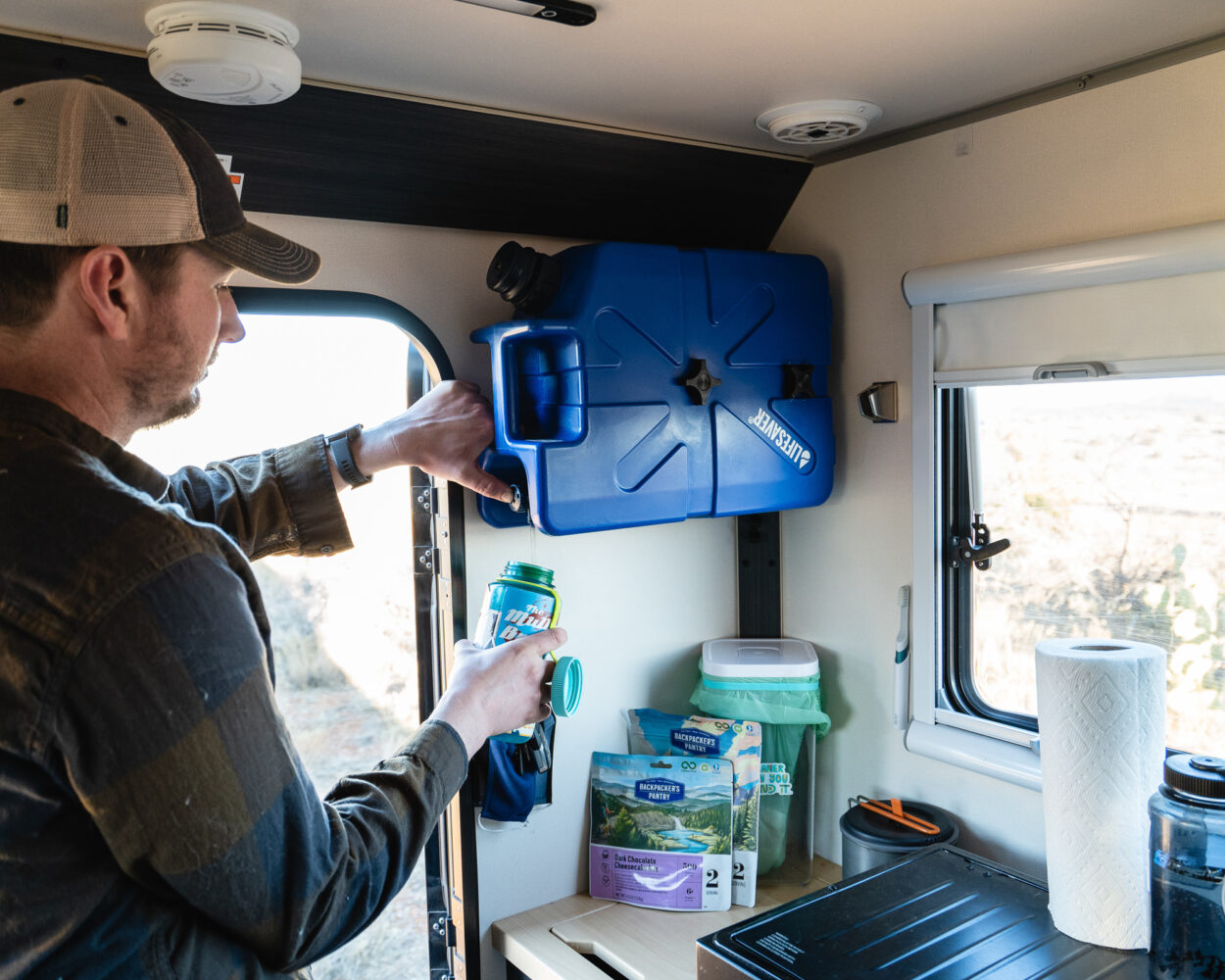
As for power, the Scout has a portable Goal Zero Yeti 1500X lithium power station, which is fed by a 175-watt Renogy Monocrystalline solar panel mounted to the roof. We also carry an additional Goal Zero Yeti 500X. Between the two and being able to charge either from solar or the truck while driving, we typically manage to have ample power for what we need (pun intended).
However, things get trickier in hot temperatures. Winter camping in the Scout is a breeze, but when it comes to camping in extreme heat (as we’ve seen this year), we haven’t found a great solution to keeping the Scout cool. Maintaining airflow with two 12-volt USB fans, parking in the shade, and spending time outside definitely helps. But with a cat who mostly prefers to hang out indoors, it’s critical that we keep the inside temps safe for him. Juggling staying cool while still getting the solar we need to keep our battery powered has proven to be quite a challenge, and we’re on the hunt for better options.
We haven’t yet felt a need to change much in the Scout. Installing a pair of custom-built teal drawers below the dinette area is currently the only major modification we’ve made. The space beneath the dinette is sizable but awkward to access. Adding the drawers on free-standing wheels (instead of rails) has transformed the space into easily accessible storage. We’ve also considered building additional shelving above the windows for clothing to avoid continually moving our duffels from the camper to the cab to optimize space. Because the camper walls are structural, you can drill and mount custom additions anywhere you like (with a proper backplate).
We opted for all of the features and add-ons offered by Scout. Our favorites are the rooftop tent and the Newport Dickinson fireplace. Having the ability to add a rooftop tent to the camper is a unique feature to the Scout compared to other truck bed campers, made possible by the hardshell and structural walls of the camper. Ours serves as a spare bedroom for friends, a part-time lair for Walker, and additional space to hang out indoors. As for the fireplace, well, there is nothing quite as peaceful as enjoying your first cup of coffee next to a cozy, open flame fireplace with a fresh layer of soft, white snow lazily falling to the ground.
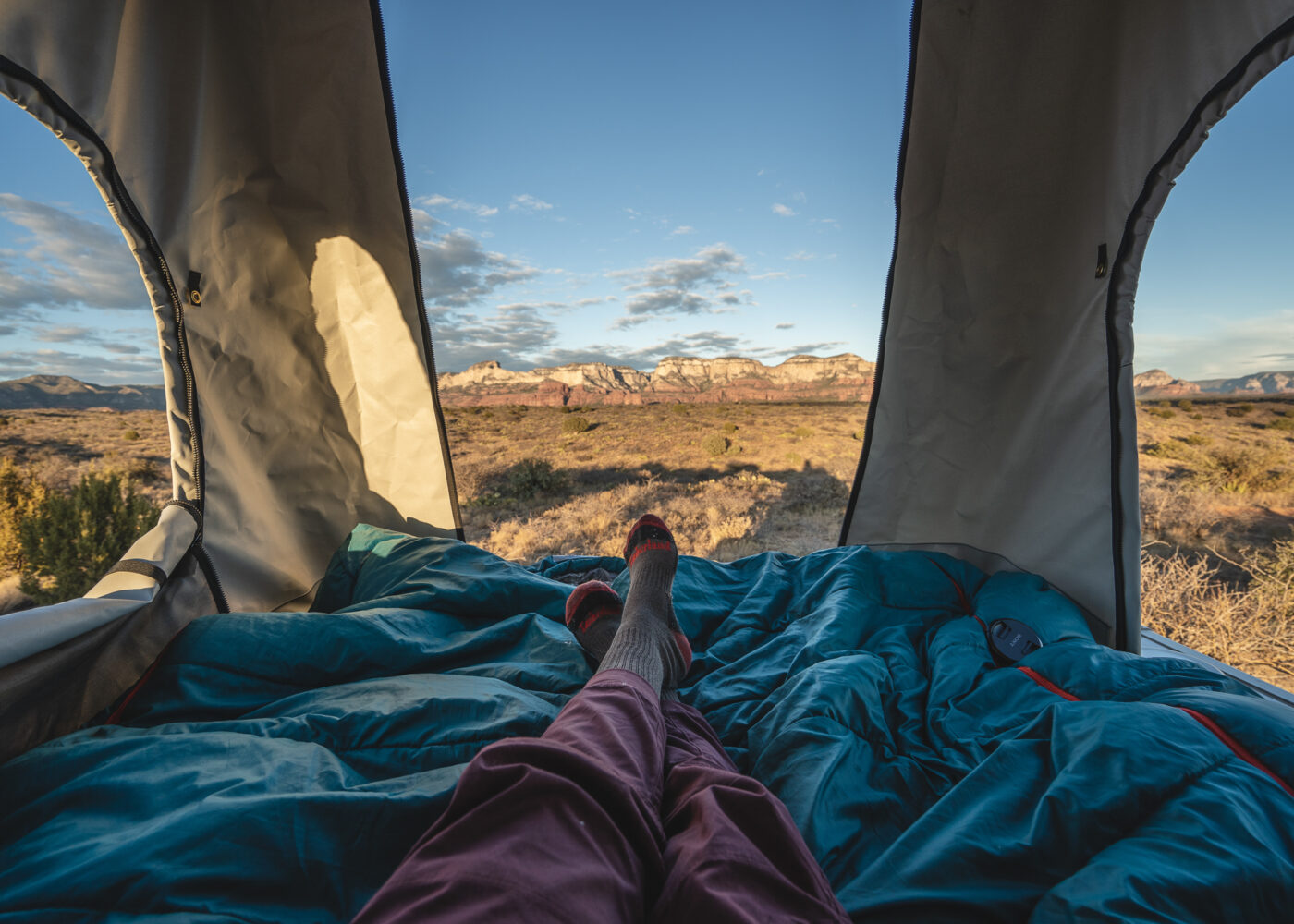
The Scout is the first camper we’ve ever owned, and sure, there are aspects of other adventure vehicles that we appreciate and would like to have, such as a pass-through to the cab, additional storage (always more storage), larger floor space, and so on. But for a couple of self-proclaimed easygoing folks who just want to spend time out in nature, it more than gets the job done; it works great for what it was designed to do, and who says we can’t continue customizing it to meet our wants and needs for longer-term travel?
The Adventure
One of the drawbacks of buying a camper from a manufacturer rather than building something yourself is the lack of originality in a mass-produced product. When you build something from scratch, you make all the design decisions, build it exactly how you want it, and essentially infuse yourself into the final product. With a manufactured camper, we had to find one that we liked and then figure out how to make it ours after the fact. Adding personal touches like art on the wall and a fake plant on the window mantle can go a long way in making a space feel homey. Still, the most significant part of making a rig your own is what you do with it and the experiences and memories you allow it to give you.
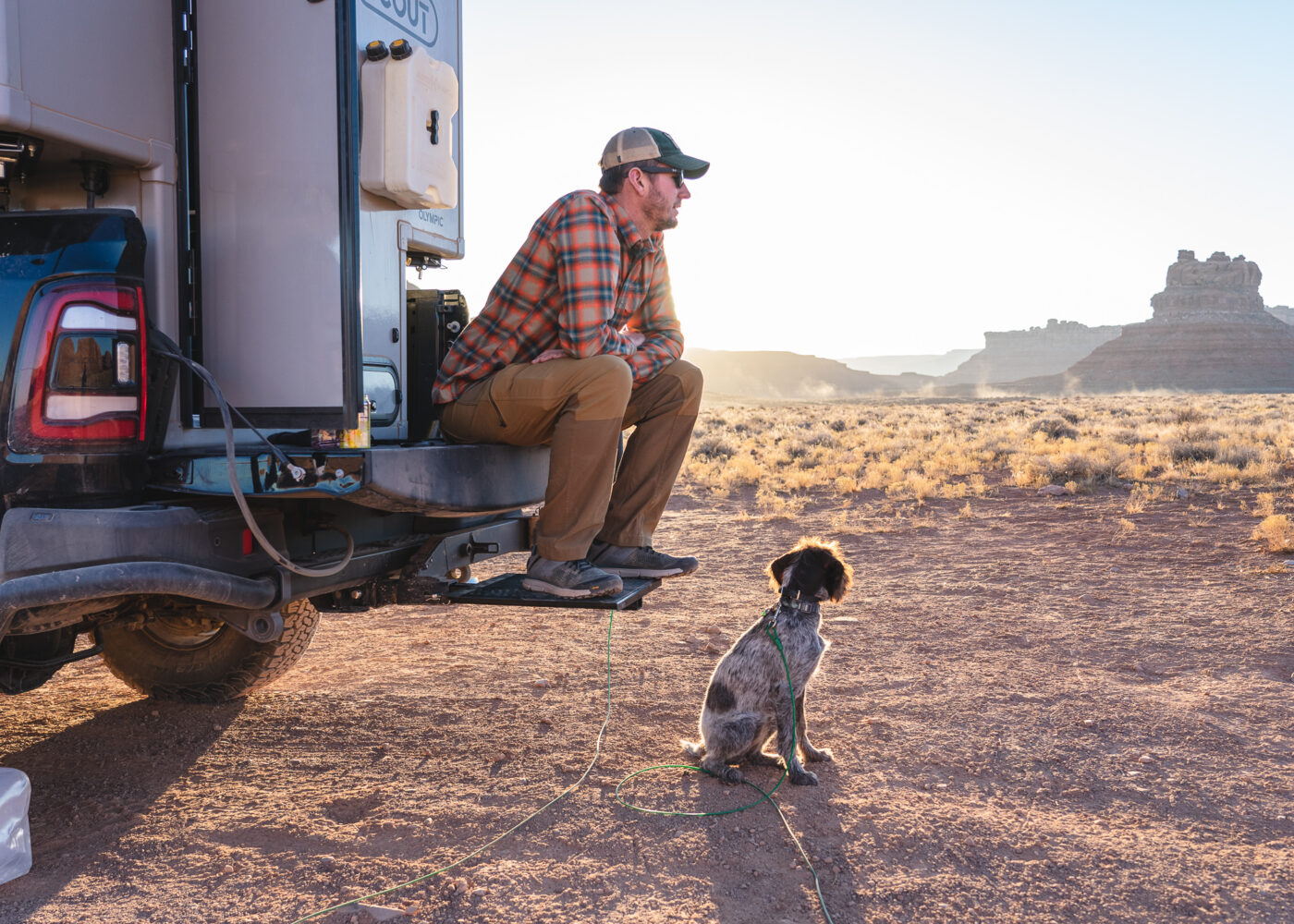
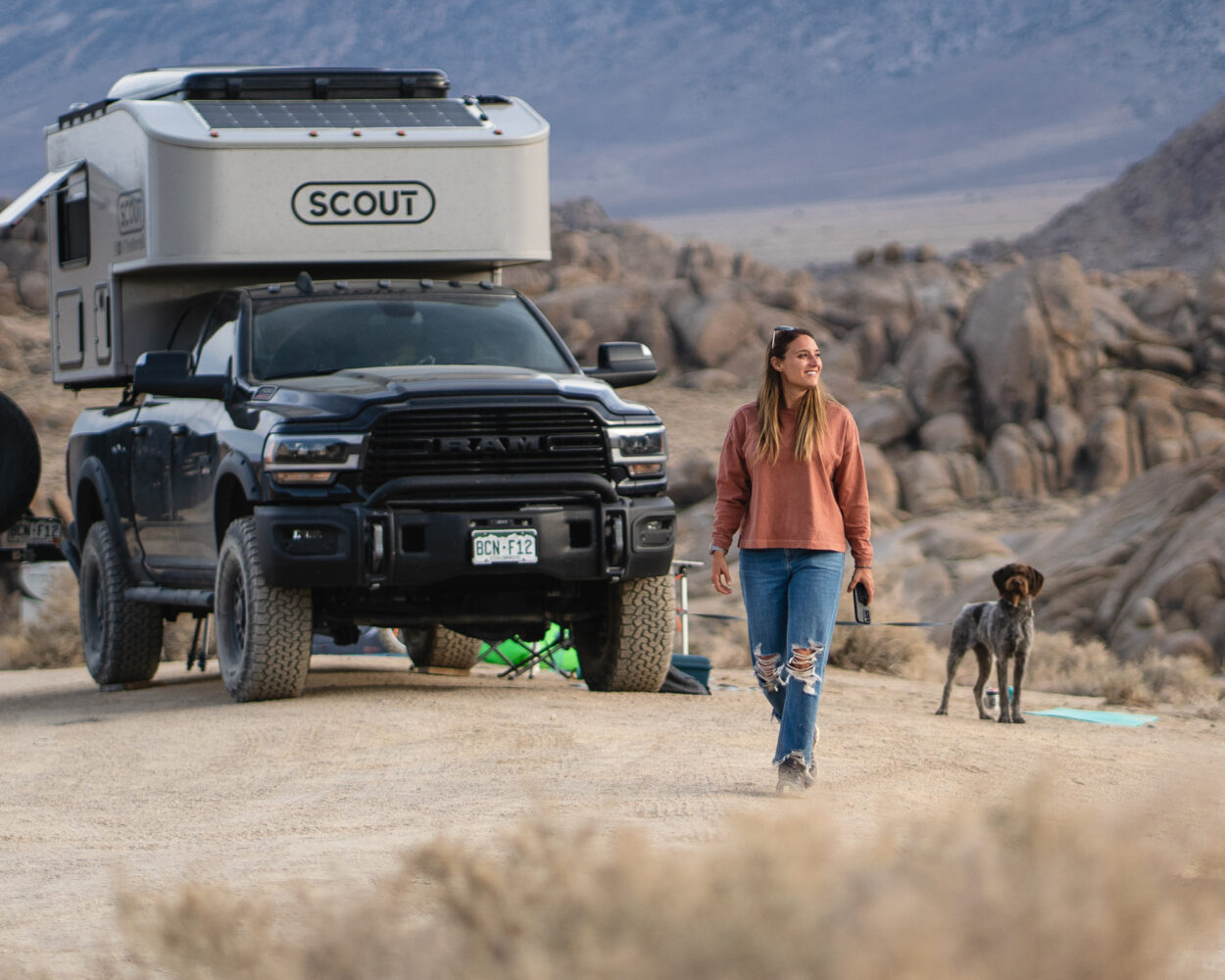
We nicknamed our rig the Mortelleporter (or “Morty” for short) because it’s the vessel that transports us from one experience to another. In less than a year, we’ve put over 20,000 miles under this rig. Traveling from the West Coast to the East and back again with lots of detours along the way, spending nights in 16 states while passing through many more, sleeping on public land, in truck stops, Cracker Barrel parking lots, family and friends’ driveways, campgrounds, and so on. Morty has lived up to its name, and though there are other Scouts out there, this one is unequivocally ours.
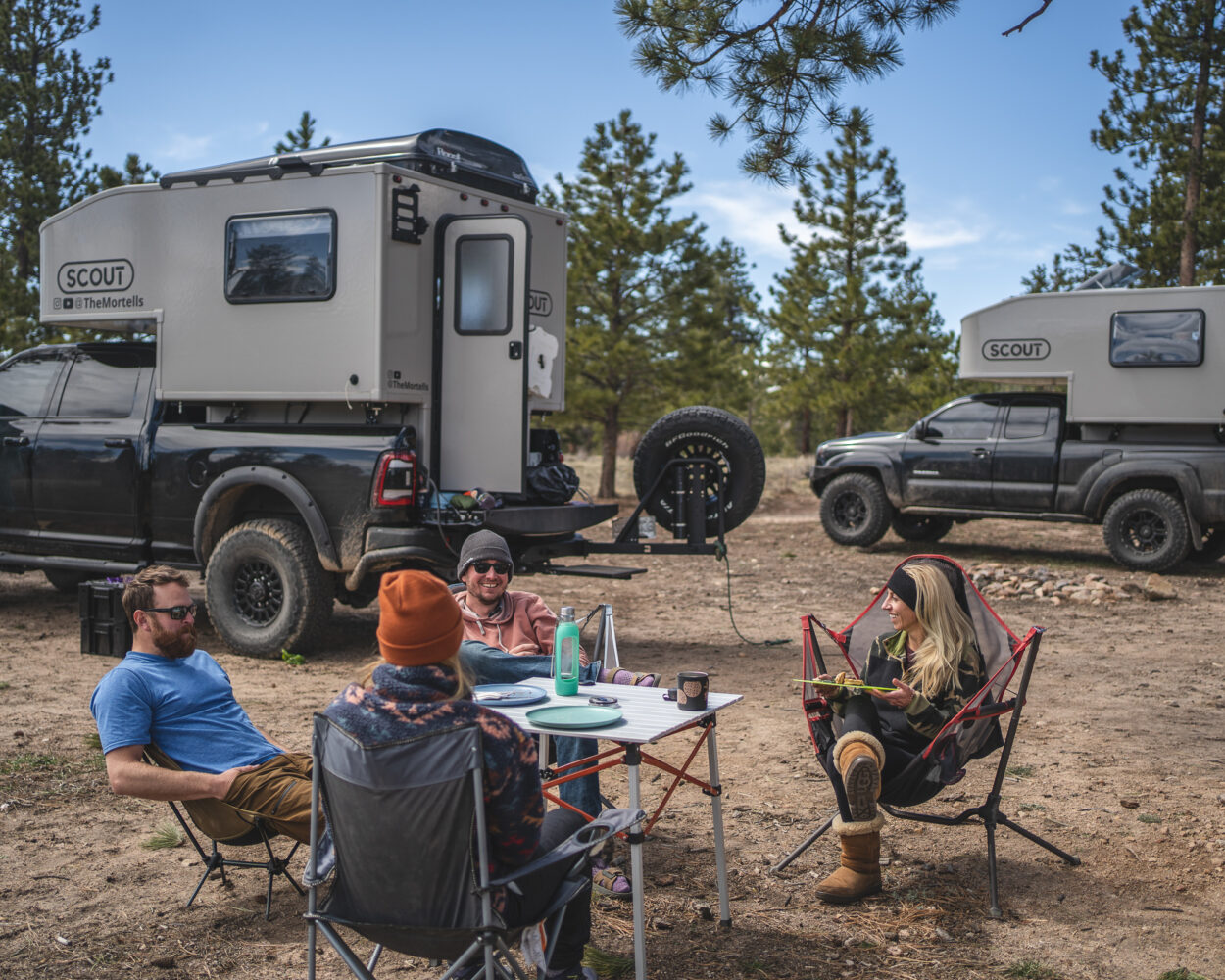
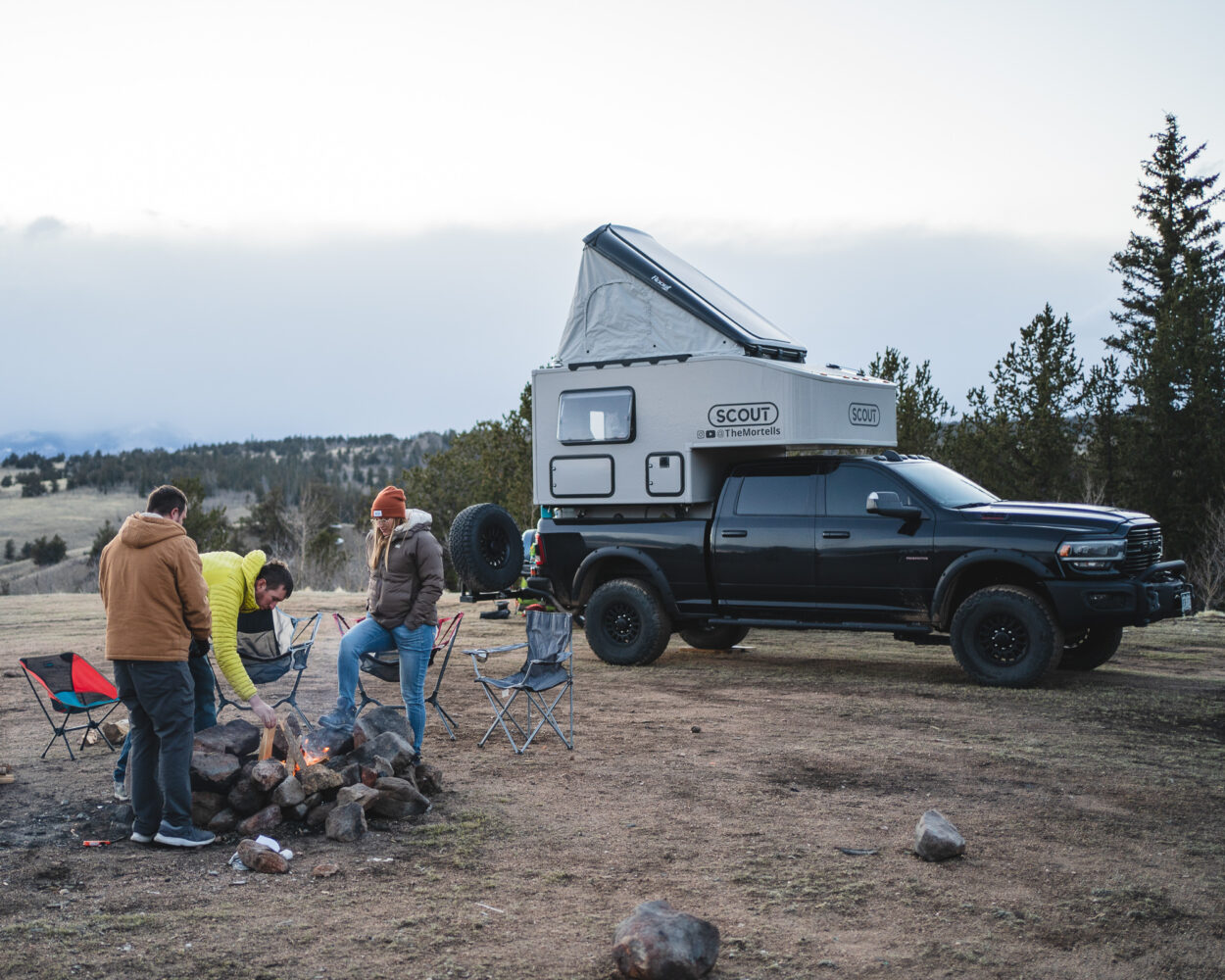
Sitting here with Granger’s head resting in my lap, I’m struck by how much joy traveling with her and Walker has brought us. Our travel needs may continue to evolve and change over time (as they did when we decided to start traveling with a dog and a cat), and so too may our vessel. What will remain constant, though, is the immense value we get from following our own path and the gratitude we share for having the opportunity to do so.
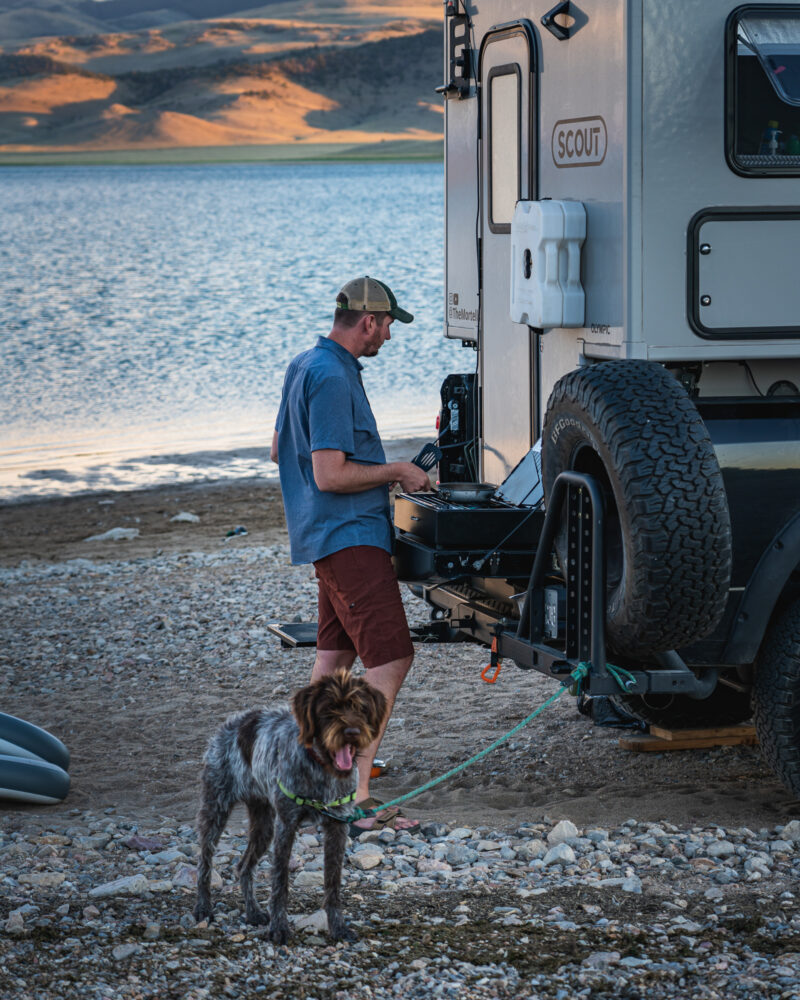
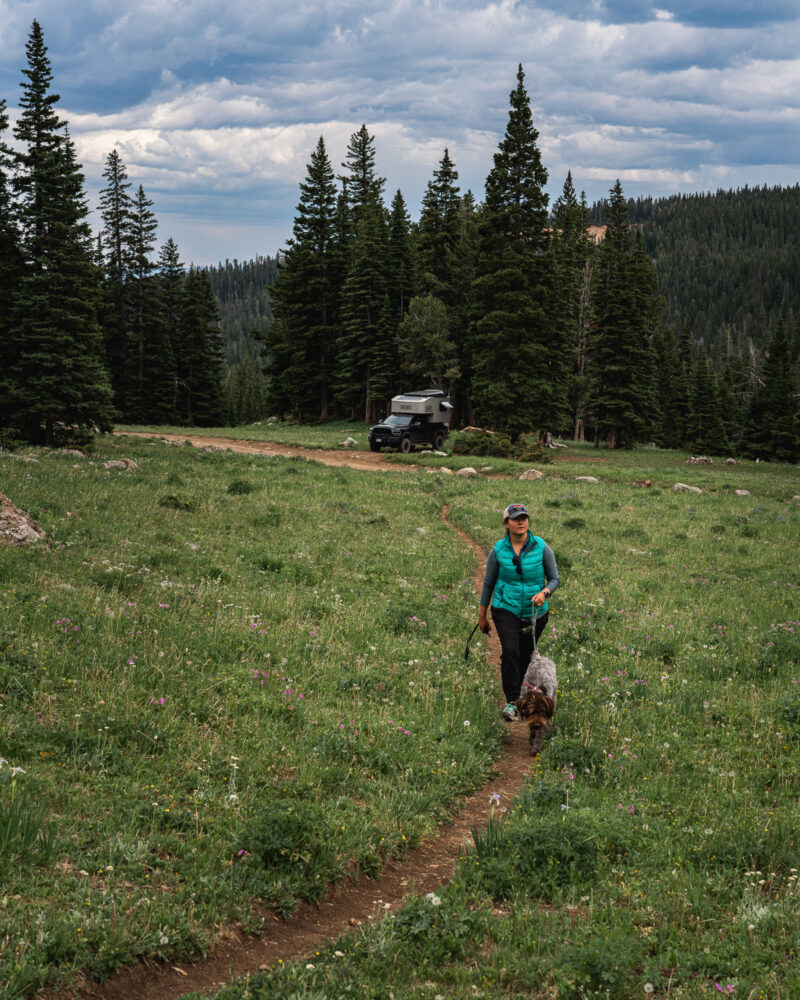
Vehicle Specifications
2020 RAM 2500 AEV Prospector
Power
6.7-liter Cummins turbo-diesel engine
6-speed automatic transmission
Suspension and Drive
AEV 3-inch DualSport RT suspension system
Four-wheel drive
Wheels and Tires
AEV Salta HD wheels
BFGoodrich 37-inch All-Terrain K02 tires
RIGd UltraSwing Mega-Fit hitch carrier with full-size spare
Recovery and Armor
AEV stamped steel front bumper
Warn 16.5-Ti synthetic winch
AEV rear bumper
Accessories
Custom storage shelf in 40-percent seat delete
Custom tripod rack
Front Runner Wolf Pack storage boxes
Pelican camera case
Camper Specifications
2021 Scout Olympic camper
Accessories
175-watt Renogy Monocrystalline solar panel
Aluminum exo-skeleton framing
Hybrid composite construction
Dual-pane windows with screen and solar-reflective shade
Dual 5-pound propane tanks with vented compartment
Lifesaver portable 4.6-gallon jerry can with charcoal filter and spray wand
Portable Goal Zero Yeti 1500X lithium power station
Dometic CFX3 75L fridge/freezer with WiFi
Gear locker, exterior pull-out tabletop with storage
Newport Dickinson Real Flame 4.5BTU gas fireplace
Roost rooftop tent with internal access hatch
Two Rotopax 2-gallon water packs
Follow the Mortelleporter’s adventures on Instagram @themortells.

Our No Compromise Clause: We carefully screen all contributors to make sure they are independent and impartial. We never have and never will accept advertorial, and we do not allow advertising to influence our product or destination reviews.


